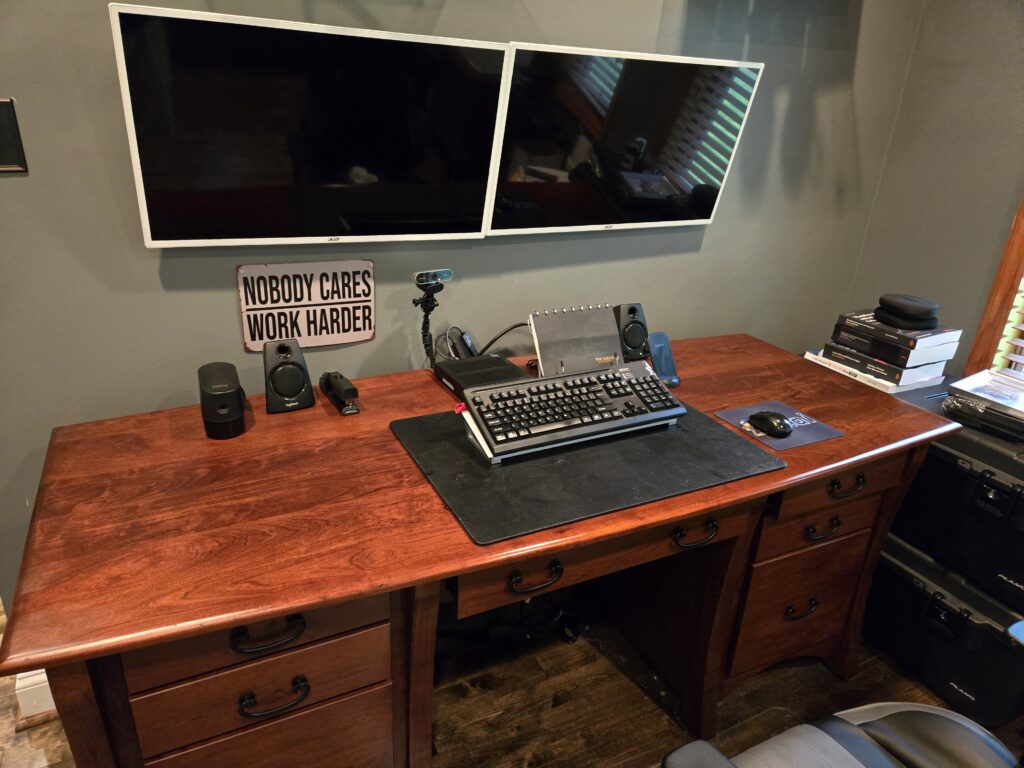I often get asked for recommendations on what equipment to buy for a home office setup. It’s important to remember that the actual computer is just one part of the equation. To truly optimize your work-from-home experience, you need to maximize your internet speed with a proper cable modem that can squeeze as much bandwidth out of your internet connection as possible.
Additionally, a high-quality meshed wireless setup with enough access points to cover your entire residence is crucial for maintaining a reliable and fast connection throughout your home.
Internet Router and Modem – maximize your internet speed. You need to get this right – especially if you are on cable internet.
I am in an older neighborhood that does not have fiber internet. Cable internet is the only wired option – and so its important to get the cable modem right – as it is usually a limiting factor to maximizing performance. I use the ARRIS SURFboard SB8200 DOCSIS 3.1 Cable Modem. This modem is approved for use with Xfinity, Cox & Spectrum.
It features two 1 Gbps ports, supports maximum internet speeds of 1 Gbps, and utilizes 4 OFDM channels. Its high performance and reliability are critical to my home office setup. Having a high-performing cable modem like this is essential to maximizing my internet speed potential, ensuring I can take full advantage of my ISP’s bandwidth. This is crucial for activities like video conferencing, large file downloads, and streaming multiple devices simultaneously. The modem can be purchased on Amazon for $130. Find it here.
Wireless Setup – maximize speed and coverage with a meshed system – and multiple access points.
For my wireless network, I use the NetGear Orbi RBR20 with a total of five satellites, creating six access points spread across my home. This setup was implemented four years ago during COVID-19, ensuring stable and robust internet connectivity for five people streaming simultaneously. The Orbi software makes the setup easy and efficient. More information on modern Orbi gear can be found here.
You can also find really good deals on ebay.com for routers and satellites using gear like mine that is a generation old. Like buying a used car – you can save tons of money purchasing something that is a couple years old.
Home Computer – Dedicated Nvidia video card and 64GB of memory
I spent good money on my main workstation – it is a Lenovo ThinkStation P3 Tiny Workstation equipped with a high-end Intel processor, 64GB of RAM, an NVIDIA 4-port video card, and 1TB of SSD storage. It takes very little desk space, runs quietly, and is amazingly powerful. I have three important criteria in my main machine.
- I connect it to my cable modem via a hardwired ethernet connection, allowing me to achieve 1Gbps download speeds. Wireless connections are much slower.
- Ensure you purchase a model with the NVIDIA dedicated video card for better graphics performance.
- Consider buying a system with 16GB of RAM and upgrading it with third-party memory to 64GB, which is more affordable than purchasing directly from Lenovo. More details here.
Monitors – My eyes can’t tell the difference, a value buy
I have two 32″ Acer EB321HQ Awi monitors, wall-mounted. These monitors offer Full HD (1920 x 1080) resolution and use IPS technology, providing excellent color accuracy and wide viewing angles. They have HDMI and VGA ports and are finished in white.
There are monitors with better specifications than these, but to be honest, my eyes can’t tell the difference, and these look amazing to me. The Acer EB321HQ Awi monitors are noted for being a good value, offering solid performance at an affordable price point. The desk real estate that the wall mounting frees up is amazing. I use an external webcam that is clamped to my desk.

Printer
I use an HP Color LaserJet Pro Multifunction M479fdw Wireless Laser Printer. This printer offers wireless connectivity, high-quality color printing, and multifunction capabilities including scanning, copying, and faxing, making it an essential tool for my home office. The scanning component is particularly impressive, featuring a document feeder that simplifies the process of scanning multiple pages. The HP Smart software works really well, as does the wireless printing, which everyone in the family uses. The only downside is the cost of toner, which is quite expensive.
This setup has been fine-tuned to ensure high performance, reliability, and comfort, enabling me to work efficiently and effectively from home. Whether you’re setting up your own home office or looking to upgrade your current equipment, these components have proven to be excellent choices for maintaining productivity and connectivity.
Note this printer has been discontinued – and the new model they are listing in place looks to be the 4301 DFW.
When I’m on the road – my laptop of choice.
For my laptop I use a Lenovo x1 Nano with 32GB of memory. Weighing just 1.99 pounds, it’s one of the lightest ThinkPads ever made, yet it performs better than most desktops, with its 11th Gen Intel Core processors and up to 32GB of RAM. The X1 Nano features a 13-inch 2K display with a 16:10 aspect ratio, offering vibrant colors and sharp details, ideal for both work and multimedia consumption. Its battery life is impressive, and nearly lasts the entire day on a charge. The only negative aspect to this machine is the lack of ports. The ultra-slim design of the X1 Nano means it sacrifices port variety, offering only two USB-C/Thunderbolt 4 ports and a headphone/mic combo jack. This minimal port selection can be inconvenient for users who rely on multiple peripheral connections, such as external monitors, storage devices, or other accessories, necessitating the use of dongles / hubs.
Cell Phone / Tablet
I am an android user and have grown fond of the Samsung flagship S series phones and tablets. They are solid devices. I have learned over the years to purchase these devices outright from Samsung and utilize their trade-in program. It’s a good deal and keeps your cell phone, perhaps your most important device, fast and with a battery that lasts all day long.
Earlier this year I upgraded from my Samsung S23 to a S24 for around $320. I upgraded my S7 tablet to a S9 for $290. I can maximize trade in value by upgrading frequently, and have a brand new phone every year for $300 – as opposed to waiting three years and spending $800 – $1,000 – effectively the same amount of money.
Accessories
A couple of my favorite accessories include the following items:
- Lasuney – portable USB C docking station – Small portable USB C docking station to connect my laptop to any accessory.
- NetGear Nighthawk Model m6 – 5G hotspot. I have service with a different provider than my main cell phone, for redundancy.
- Anker – S3 Speaker – BlueTooth, battery powered. I use it on my laptop and cell phone.
I hope this was helpful!


